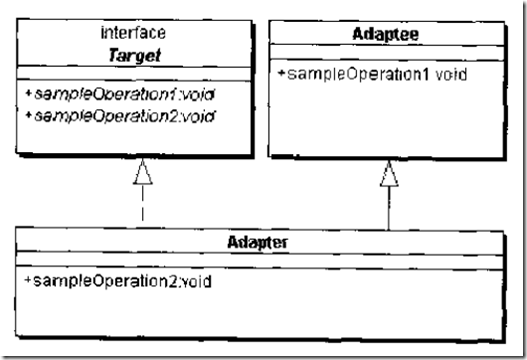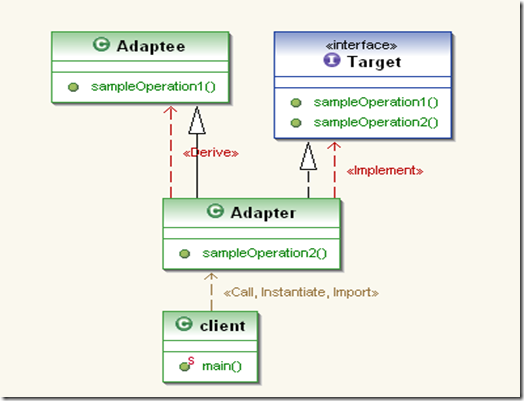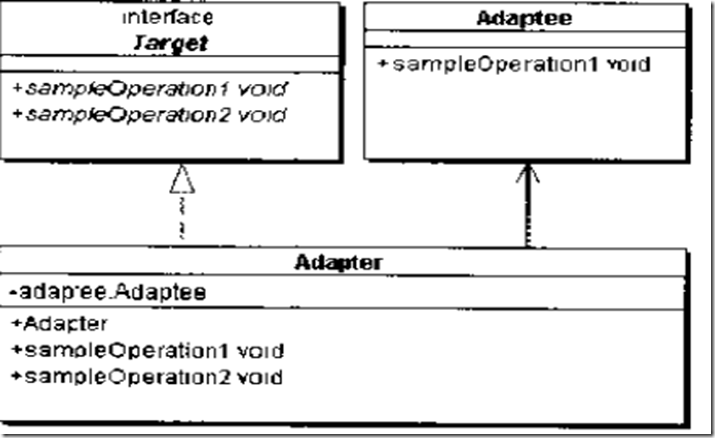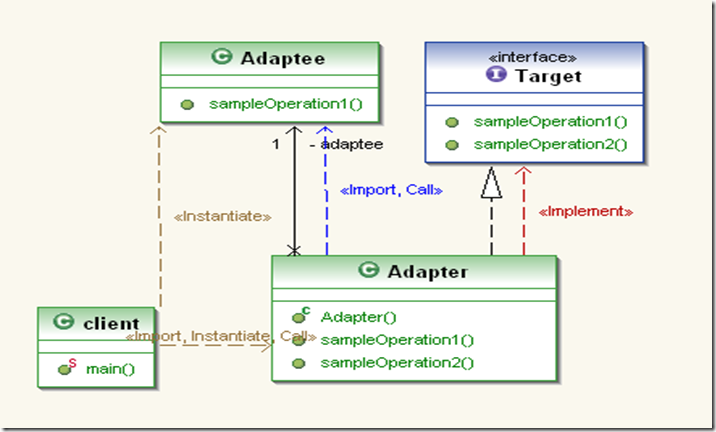结构模式有下面这些:适配器模式,缺省适配模式,合成模式,装饰模式,代理模式,享元模式,门面模式,桥接模式等.
适配器模式有类的适配器模式和对象的适配器模式两种不同的形式。如下图所示,左边是类的适配器模式,右边是对象的适配器模式。
类的适配器模式把被适配的类的API转换成为目标类的API,其静态结构图如下图所示:
在上图中可以看出,Adaptee类并没有sampleOperation2()方法,而客户端则期待这个方法。为使客户端能够使用Adaptee类,提供一个中间环节,即类Adapter,把Adaptee的API与Target类的API衔接起来。Adapter与Adaptee是继承关系,这决定了这个适配器模式是类的。
角色:
1、目标(Target):这就是所期待得到的接口。
2、源(Adaptee):现有需要适配的接口。
3、适配器(Adapter):适配器类是本模式的核心。适配器把源接口转换成目标接口。
代码:
package com.javapatterns.adapter.classAdapter;
public class Adaptee {
public void sampleOperation1(){
System.out.println("方法名 "+Thread.currentThread().getStackTrace()[1].getMethodName());
System.out.println("类名 "+Thread.currentThread().getStackTrace()[1].getClassName());
System.out.println("文件名 " + Thread.currentThread().getStackTrace()[1].getFileName());
System.out.println("所在的行数 "+Thread.currentThread().getStackTrace()[1].getLineNumber());
}
}
package com.javapatterns.adapter.classAdapter;
public interface Target {
/**
* Class Adaptee contains operation sampleOperation1.
*/
void sampleOperation1();
/**
* Class Adaptee doesn't contain operation sampleOperation2.
*/
void sampleOperation2();
}
package com.javapatterns.adapter.classAdapter;
public class Adapter extends Adaptee implements Target {
/**
* Class Adaptee doesn't contain operation sampleOperation2.
*/
public void sampleOperation2(){
// Write your code here
sampleOperation1();
}
}
/**
* 测试类适配器模式
*/
package com.javapatterns.adapter.classAdapter;
/**
* @author luhx
*
*/
public class client {
/**
* @param args
*/
public static void main(String[] args) {
// TODO Auto-generated method stub
Adapter a= new Adapter();
a.sampleOperation2();
}
}
对象的适配器模式
对象的适配器模式把被适配的类的API转换成为目标类的API,与类的适配器模式不同的是,对象的适配器模式不是使用继承关系连接到Adaptee类,而是使用委派关系连接到Adaptee类。
从图中可以看出,Adaptee类并没有sampleOperation2()方法,而客户端则期待这个方法。为使客户端能够使用Adaptee类,需要提供一个包装(Wrapper)类Adapter。这个包装类包装了一个Adaptee的实例,从而此包装类能够把Adaptee的API与Target类的API衔接起来。Adapter 与Adaptee是委派关系,这决定了这个适配器模式是对象的。
源代码结构图:
package com.javapatterns.adapter.objectAdapter;
/**
* @author luhx
*
*/
public class client {
/**
* @param args
*/
public static void main(String[] args) {
// TODO Auto-generated method stub
Adapter a = new Adapter(new Adaptee());
a.sampleOperation2();
}
}
package com.javapatterns.adapter.objectAdapter;
public class Adapter implements Target {
public Adapter(Adaptee adaptee){
super();
this.adaptee = adaptee;
}
public void sampleOperation1(){
}
public void sampleOperation2(){
// Write your code here
adaptee.sampleOperation1();
}
/**
* @uml.property name="adaptee"
* @uml.associationEnd multiplicity="(1 1)"
*/
private Adaptee adaptee;
}
package com.javapatterns.adapter.objectAdapter;
public class Adaptee {
public void sampleOperation1(){
System.out.println("方法名 "+Thread.currentThread().getStackTrace()[1].getMethodName());
System.out.println("类名 "+Thread.currentThread().getStackTrace()[1].getClassName());
System.out.println("文件名 " + Thread.currentThread().getStackTrace()[1].getFileName());
System.out.println("所在的行数 "+Thread.currentThread().getStackTrace()[1].getLineNumber());
}
}
package com.javapatterns.adapter.objectAdapter;
public interface Target {
/**
* Class Adaptee contains operation sampleOperation1.
*/
void sampleOperation1();
/**
* Class Adaptee doesn't contain operation sampleOperation2.
*/
void sampleOperation2();
}




